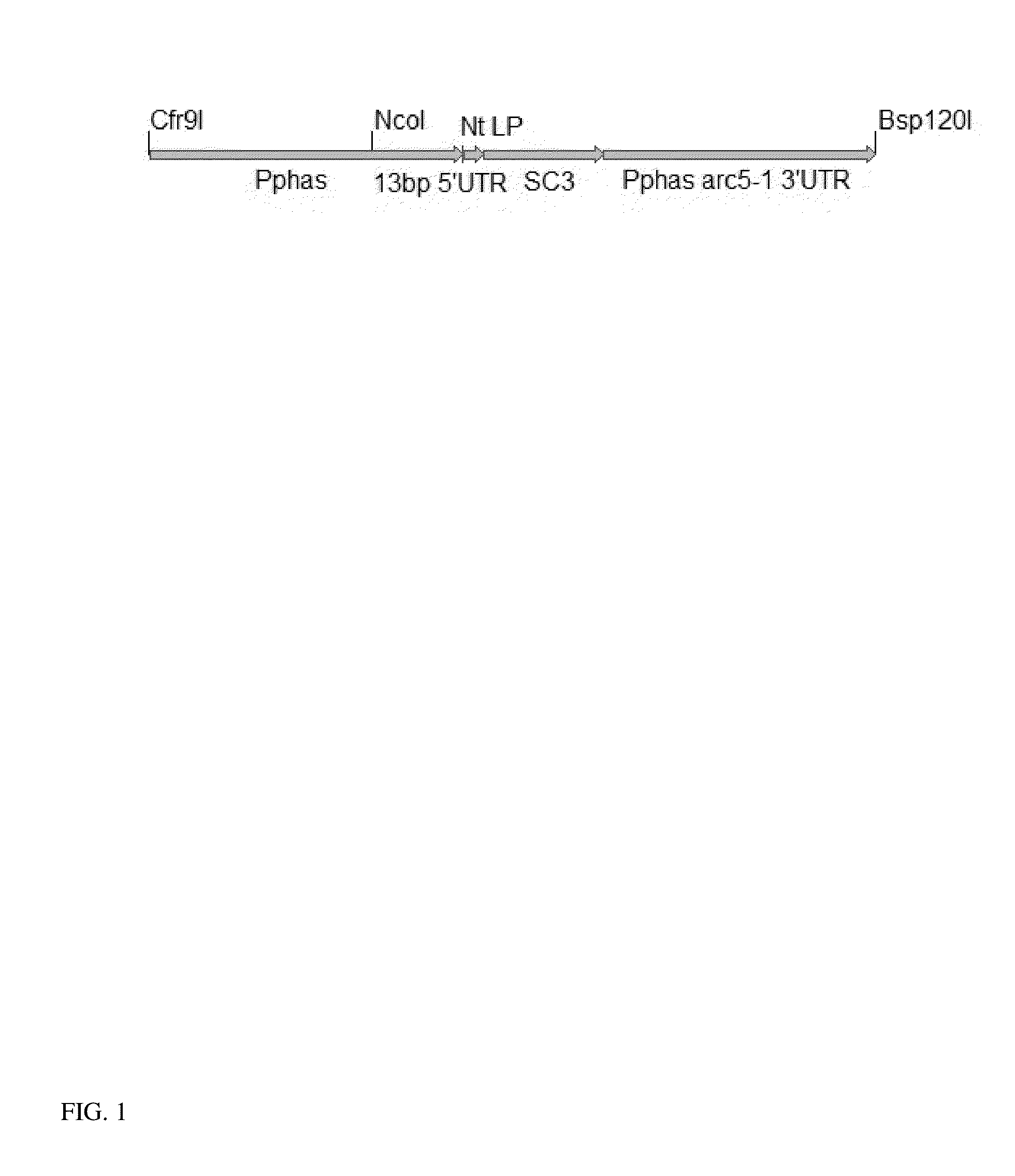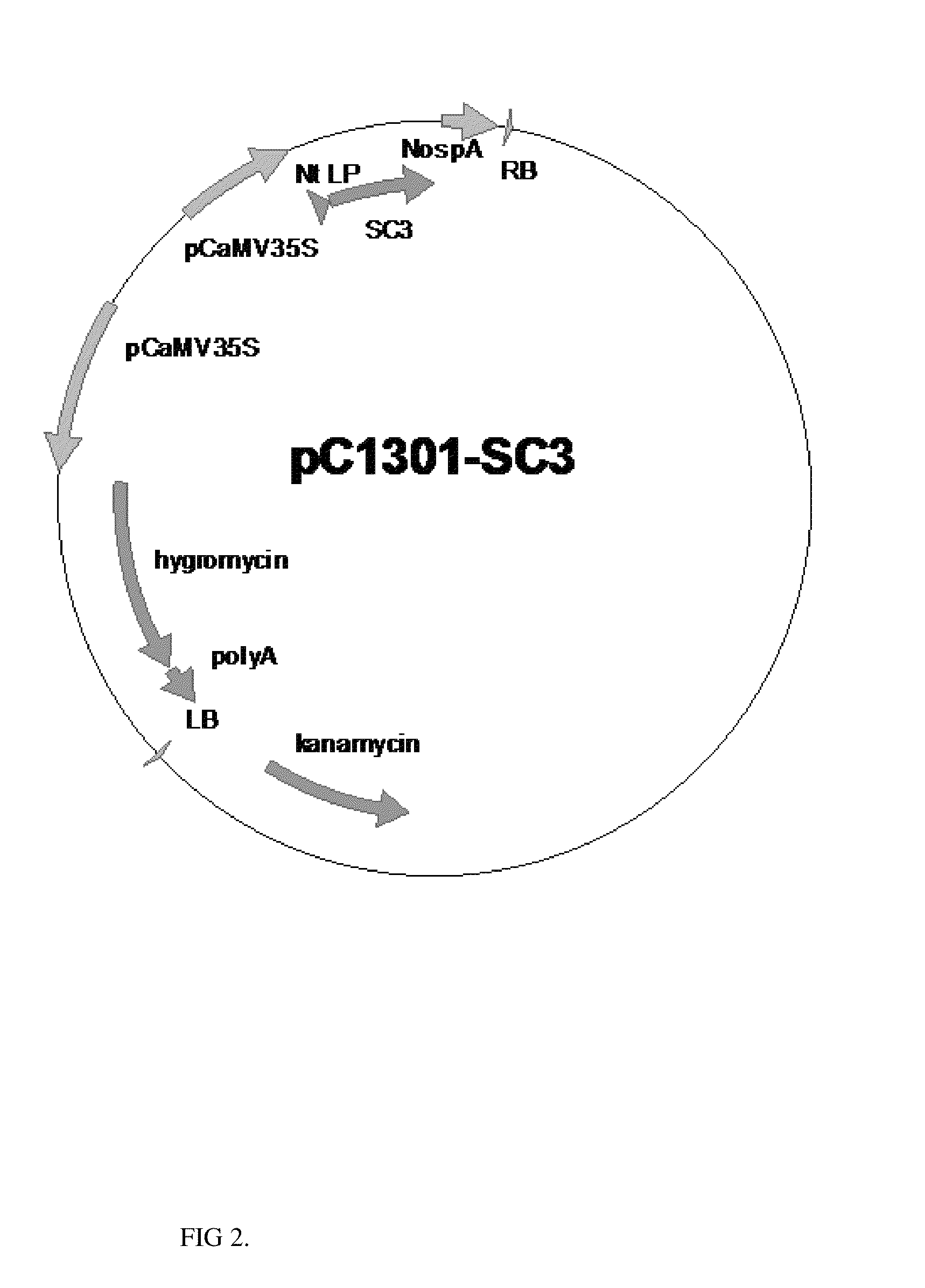Method for hydrophobin production in plants and methods to produce hydrophobin multimers in plants and microbes
a technology of hydrophobin and plant, applied in the field of protein production, can solve the problems of insufficient protein that can be obtained using this method for commercial applications, insufficient hydrophobin production yield of all approaches, and insufficient production of hydrophobins in microbial cells, etc., and achieve the effect of producing high amounts of hydrophobins
- Summary
- Abstract
- Description
- Claims
- Application Information
AI Technical Summary
Benefits of technology
Problems solved by technology
Method used
Image
Examples
example 1
Construction of Seed Specific Expression Cassette
[0062]Seed specific expression cassette with Phaseolus vulgaris phaseolin promoter sequence, arcelin 5′ UTR and arcelin 3′ UTR was constructed as follows.
[0063]Genomic DNA for PCR amplification of Phaseolus vulgaris control elements is extracted from germinated seedlings with standard extraction methods. Alternatively, a kit like Fermentas GeneJet Genomic DNA extraction kit is used. Phaseolus vulgaris phaseolin promoter sequence (Genebank accession number J01263; SEQ ID NO:1) is amplified with primers o 1 (SEQ ID NO:9) and o 13 (SEQ ID NO:14) from genomic DNA of Phaseolus vulgaris (Table 1) to correspond nucleotides −1 to −1470 of the promoter sequence. Short homology stretches with vector backbone containing Cfr9I restriction site at the 5′end and with Phaseolus vulgaris arcelin 5′ UTR and expressed gene of interest at the 3′ end are introduced into the sequence with PCR primers. Synthetic gene sequence with Nicotiana tabacum leader ...
example 2
Construction of Expression Cassettes with Continuously Expressed Promoter
[0066]To enable the expression of hydrophobin genes in leaves and other vegetative parts of plant, expression cassette with continuously expressed 35S promoter is constructed. Schizophyllum commune SC3 sequence with Nicotiana tabacum leader peptide (SEQ ID NO:2) is amplified with primers with NcoI (5′) and BstEII (3′) restriction sites. Amplified sequences are cloned to plant binary expression vector pCAMBIA1301 under the control of 35S promoter.
[0067]Synthetic Schizophyllum commune hydrophobin SC3 gene is amplified with primers o21 (SEQ ID NO:15) and o22 (SEQ ID NO:16) from seed specific expression vector. Amplified sequence is cut with restriction endonucleases NcoI / BstEII and cloned to plant binary vector pCAMBIA1301 cut with NcoI / BstEII, to yield final vector pC1301-SC3 (FIG. 2).
[0068]Alternatively, detection- and purification tags, like 6HIS- or STREP-tags, can be introduced to C-terminus of hydrophobin by...
example 3
Construction of Expression Cassettes for Multimeric Hydrophobin Polymer
[0069]To demonstrate the production of multimeric hydrophobin polymer, a repetitive linker sequence from elastin is used for multimerization.
[0070]A synthetic sequence with Trichoderma reesei hydrophobin 1 (UniProt accession number P52754), elastin-derived linker (SEQ ID NO:25) and factor XA protease cleavage sites between the monomers (SEQ ID NO:5 for synthetic multimer gene, SEQ ID NO:6 for synthetic multimer amino acid sequence) is amplified with primers o23 (SEQ ID NO:17) and o25 (SEQ ID NO:18) with overlaps allowing the cloning into seed specific expression cassette (example 1) or with primers o26 (SEQ ID NO:19) and o27 (SEQ ID NO:20) allowing the cloning into continuously expressed expression cassette (example 2).
TABLE 3Primer sequencesPrimerSequenceo23GATCATGCATTCAGAAAGAAGTGAGTGATATTAGAGG (SEQID NO: 17)o25GGGAAGGTGGTTTTGGGAGTTCAAGCACCAACAGCGGTC(SEQ ID NO: 18)o26CACAGAAGACCACATGAAGTTCTTCGCTATCGCTGC (SEQID N...
PUM
| Property | Measurement | Unit |
|---|---|---|
| Electrical conductance | aaaaa | aaaaa |
Abstract
Description
Claims
Application Information
 Login to View More
Login to View More - R&D
- Intellectual Property
- Life Sciences
- Materials
- Tech Scout
- Unparalleled Data Quality
- Higher Quality Content
- 60% Fewer Hallucinations
Browse by: Latest US Patents, China's latest patents, Technical Efficacy Thesaurus, Application Domain, Technology Topic, Popular Technical Reports.
© 2025 PatSnap. All rights reserved.Legal|Privacy policy|Modern Slavery Act Transparency Statement|Sitemap|About US| Contact US: help@patsnap.com


